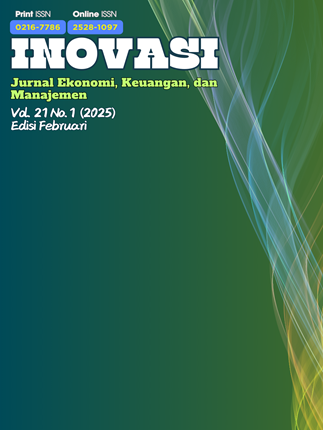Regulation of The Minister of Finance of The Republic of Indonesia Number 131 of 2024 on The Increase of Vat By 12% and Its Impact
DOI:
https://doi.org/10.30872/jinv.v21i1.2686Keywords:
Tax Reform, Increase in VAT, Value-Added TaxAbstract
The increase in the Value Added Tax (VAT) rate to 12% planned for 2025 is part of the tax reform efforts outlined in the Harmonization of Tax Regulations Law (UU HPP). This policy aims to increase state revenue, support national development, and create a fairer tax system. In addition, the increase in VAT rates is expected to strengthen the government's fiscal resilience in facing global economic challenges, including economic uncertainty and the need for financing for strategic infrastructure projects. This reform also aims to align domestic tax policies with international standards to enhance Indonesia's economic competitiveness and attract more foreign investment. PMK 131 of 2024 states that the increase in the Value Added Tax (VAT) rate to 12% will not be applied universally, but only to luxury goods. The government maintains the principle of fairness by providing different tax treatments for various types of goods and services. For luxury goods, VAT is calculated at the full rate of 12% of the selling price or import value, with a transition period until January 31, 2025, during which the effective rate remains 11% through another value mechanism of 11/12 of the selling price. Meanwhile, for goods other than luxury goods, services, and intangible goods, VAT is imposed at a rate of 12%, but calculated using the DPP value of 11/12 of the import value, selling price, or replacement value, so the effective rate remains 11%. In addition, there are exceptions for certain Taxable Goods (BKP) and Taxable Services (JKP) that are subject to VAT with a different DPP value or specific amounts, such as 3 kg LPG, gold jewelry, and used motor vehicles, which will continue to follow the previous regulations and are not affected by this policy. This change also impacts the tax administration system, including the use of tax invoice serial number codes from 010 to 040 for transactions with different taxable base values. With this policy, the government is striving to balance the need to increase state revenue with maintaining the purchasing power of the public and the continuity of businesses. The transition period for luxury goods shows the government's efforts to provide adaptation before the full implementation of the 12% VAT rate
References
Agasie, D., & Zubaedah, R. (2022). Urgensi Kenaikan Tarif Pajak Pertambahan Nilai Berdasarkan Asas Kepentingan Nasional. Perspektif Hukum, 50–74. https://doi.org/10.30649/ph.v22i2.131
Anggreny Bangsawan A., & Alkam, R. (2023). Implikasi atas Kenaikan Tarif PPN terhadap Orang Pribadi dan Pengusaha Guna Optimalisasi Penerimaan Negara Pasca Pandemi. SEIKO : Journal of Management & Business, 6(1), 83–93. https://doi.org/10.37531/sejaman.v6i1.3771
Christanti Kwan, M., Sarjono, B., Studi Manajemen Pemasaran, P., Studi Perpajakan, P., & Ubaya, P. (n.d.). DAMPAK KENAIKAN TARIF PAJAK PERTAMBAHAN NILAI PADA PERILAKU KONSUMEN DI INDONESIA.
Dewi noor Sani. (2020). Deskripsi Perusahaan Dagang - Pengertian, Ciri, Akun, Syarat Penyerahan Barang, Syarat Pembayaran .
Direktur, P., Pajak, J., Pertambahan, P., Atas, N., Barang, I., Pajak, K., Barang, P., Jasa, P., Barang, P., Berwujud, T., Luar, D., Pabean, D., Dalam, D., & Jasa, P. (n.d.). KEMENTERIAN KEUANGAN REPUBLIK INDONESIA.
Farida, N., Politeknik, L., Negara, K., Korespondensi, S. A., & Id, F. A. (n.d.). Halaman 124 MENELAAH RENCANA KENAIKAN TARIF PPN BERDASARKAN BUKTI EMPIRIS SERTA DAMPAKNYA SECARA MAKRO EKONOMI. www.jurnal.pknstan.ac.id/index.php/JPI
Hikmayani Subur, & Wahyu Muh Syata. (2024a). ANALISIS DAMPAK KENAIKAN TARIF PAJAK PERTAMBAHAN NILAI (PPN) TERHADAP MASYARAKAT DAN INFLASI DI INDONESIA. JURNAL RUMPUN MANAJEMEN DAN EKONOMI, 1(5), 205–210. https://doi.org/10.61722/jrme.v1i5.3045
Hikmayani Subur, & Wahyu Muh Syata. (2024b). ANALISIS DAMPAK KENAIKAN TARIF PAJAK PERTAMBAHAN NILAI (PPN) TERHADAP MASYARAKAT DAN INFLASI DI INDONESIA. JURNAL RUMPUN MANAJEMEN DAN EKONOMI, 1(5), 205–210. https://doi.org/10.61722/jrme.v1i5.3045 KETERANGAN TERTULIS. (n.d.).
Margaret, K., Sitanggang, O., Wahyu, N., & Kiranan, I. (n.d.). Analisis Perubahan Kebijakan … (Vol. 9, Issue 9).
Marsela Rosiana Putri. (n.d.). Implikasi Undang-Undang Nomor 7 Tahun 2021 tentang Pertambahan Tarif PPN 11% terhadap Pelaku Usaha Kerajinan Lokal di Kota Malang.
Marsela Rosiana Putri 150. (n.d.). N. Purnomo, & R.Soerjatno. (2021). Pajak Pertambahan Nilai & Pajak Penjualan Atas Barang Mewah.
Penyerahan, U., & Goreng, E. M. (n.d.). TATA CARA PEMBUATAN FAKTUR PAJAK. PERATURAN MENTERI KEUANGAN REPUBLIK INDONESIA NOMOR 131 TAHUN 2024. (n.d.).
PMK-81 Tahun 2024 Ketentuan Perpajakan dalam rangka Pelaksanaan Sistem Inti Administrasi Perpajakan TAX TAX TAX REGISTRATION TAX. (n.d.). www.pajak.go.id ReformasiPerpajakanKenaikanPPnTahun2025DanDampaknya. (n.d.).
Septia Putri, R. (n.d.). Analisis Perhitungan, Pelaporan dan Kenaikan Tarif PPN 11% Terhadap Pendapatan Perusahaan (Studi Kasus PT XYZ).
Vidya. (n.d.). Reformasi Perpajakan: Kenaikan PPn Tahun 2025 Dan Dampaknya.
Downloads
Published
Issue
Section
License
Copyright (c) 2025 Nur Alfiah Rezkiyanti, Ema Christiana Hutabarat, Desy Natalia, L.M Hasriadi, Tantaka A.Tao

This work is licensed under a Creative Commons Attribution-ShareAlike 4.0 International License.






